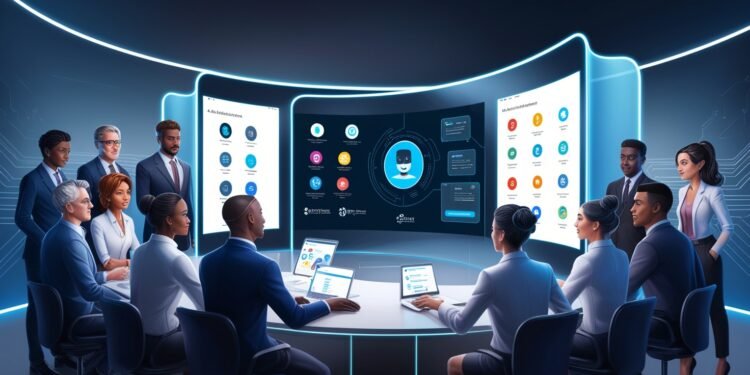In today’s fast-paced digital landscape, AI chatbots are increasingly becoming an essential tool for agencies looking to improve client interactions, enhance customer service, and automate routine tasks. The right AI chatbot can help your agency engage with clients in real time, handle common inquiries, and support marketing efforts around the clock. However, with so many options available, choose the right one for your needs is crucial.
This article will guide you through the key factors to consider when selecting an AI chatbot for your agency.
1. Define Your Chatbot’s Purpose
Before choosing a chatbot, it’s essential to first identify the main purpose of the tool. Chatbots can serve various roles, and defining this upfront will help you narrow down your options, especially when working with a chatbot marketing agency to align the tool with your business goals. Some of the common uses for AI chatbots in an agency setting include:
- Customer support: Responding to frequently asked questions (FAQs), troubleshooting, or addressing client issues.
- Lead generation: Engaging with website visitors to qualify leads by asking questions and offering tailored information.
- Appointment booking: Automating scheduling and appointment-setting for consultations or meetings.
- Content delivery: Providing clients with access to resources like blogs, case studies, or newsletters.
Understanding the specific use case for your chatbot will help you select a platform that excels in those areas.
2. Consider the Level of Automation You Need
AI chatbots come in different levels of sophistication. Some chatbots are simple, rule-based systems that follow pre-defined paths based on user inputs. Others are more advanced, leveraging machine learning (ML) and natural language processing (NLP) to understand context, tone, and intent.
- Basic chatbots are useful for handling routine inquiries, directing users to appropriate resources, or collecting basic information.
- Advanced chatbots can engage in more complex conversations, adapt to different user intents, and escalate queries to human agents when necessary.
For most agencies, a more advanced AI chatbot with the ability to learn and adapt can provide greater value, especially if you plan to scale client interactions over time. However, if your primary need is handling simple tasks like FAQ responses, a more basic option may suffice.
3. Evaluate Integration with Existing Tools
Your agency likely already uses a range of digital tools for communication, project management, CRM, and marketing automation. When selecting an AI chatbot, it’s important to consider how well it integrates with your current systems. Here are a few integrations that might be relevant:
- CRM systems: Integration with CRM platforms like HubSpot, Salesforce, or Zoho helps chatbots access client data, improving interactions by providing personalized responses.
- Email marketing tools: A chatbot that connects with your email marketing software can trigger automated email campaigns or respond to leads captured through the bot.
- Scheduling tools: If appointment scheduling is part of your chatbot’s role, integration with calendar platforms like Google Calendar or Microsoft Outlook is crucial.
- Helpdesk platforms: If your agency uses a tool like Zendesk or Freshdesk for customer support, ensure your chatbot can sync with these platforms to provide a unified experience for your clients.
Choosing a chatbot that integrates with your existing tools helps ensure smooth operations and enhances your chatbot’s effectiveness.
4. User-friendliness and Customization
Your team will need to set up and possibly customize the AI chatbot to align with your agency’s needs. It’s important to choose a platform that’s user-friendly and allows you to modify the bot’s responses, workflows, and personality without needing a lot of technical expertise.
Look for the following features:
- Easy setup: A platform with a simple interface and drag-and-drop functionality makes it easier for non-technical users to design and deploy chatbots.
- Customizable dialogues: Some platforms allow you to tailor chatbot responses based on different client segments or interaction scenarios.
- Visual flow builder: This feature enables you to design the chatbot’s conversational paths visually, which can be particularly useful for creating personalized client journeys.
The more customization options available, the better you can align the chatbot with your brand’s tone and objectives.
5. Assess the Quality of Customer Support
When adopting a new technology, it’s important to have access to good customer support in case you encounter any issues. A chatbot platform with responsive customer service can save you time and stress when troubleshooting or making adjustments to your setup.
Look for platforms that offer:
- 24/7 customer support: Especially if the chatbot will be handling interactions outside of regular business hours, having round-the-clock support can help keep things running smoothly.
- Comprehensive knowledge base: A well-organized library of articles, tutorials, and FAQs can help you resolve issues quickly without needing to contact support.
- Community forums: Some platforms have active user communities where you can share best practices and seek advice from other businesses.
The availability and quality of customer support can be a game-changer in the success of your chatbot implementation.
6. Monitor Performance with Analytics
One of the major benefits of using an AI chatbot is the ability to track performance and gain insights into customer behavior. Choose a chatbot platform that offers robust analytics and reporting tools. This will help you monitor key metrics such as:
- Response times: How quickly is the chatbot responding to users?
- User engagement: Are users interacting with the bot, and are those interactions meaningful?
- Conversion rates: How effective is the chatbot at converting visitors into leads or clients?
- Sentiment analysis: Does the chatbot correctly identify user intent, and is it able to address issues or escalate queries to human agents?
Having access to this data will enable you to optimize your chatbot’s performance over time and ensure it delivers real value to your agency.
7. Consider the Cost
AI chatbots can vary significantly in cost, depending on the features and level of customization they offer. While it’s tempting to choose a chatbot platform based on cost alone, it’s important to evaluate its features and benefits in relation to its price.
- Subscription-based models: Many chatbot platforms offer monthly or annual subscription plans based on the number of users, interactions, or features you need.
- Pay-as-you-go models: Some chatbots operate on a pay-per-interaction or pay-per-user model, which can be more suitable for agencies with fluctuating traffic.
- Free trials: Many chatbot providers offer free trials that let you test the platform before committing to a paid plan. Take advantage of these trials to assess the platform’s performance and usability.
While cost is important, ensure that the chatbot you choose provides the features that best align with your agency’s goals.
8. Test Before Committing
Most AI chatbot platforms offer free trials or demos that allow you to test out the software before making a commitment. Take advantage of these trials to test the chatbot’s capabilities, user experience, and integration options. Focus on the following during the trial phase:
- Ease of setup: Is the platform easy to use and set up for your specific use case?
- User experience: How does the chatbot interact with users, and how well does it understand various inputs?
- Integration capabilities: Can it integrate with the other tools you currently use, and does it work well within your workflow?
- Response quality: Evaluate how well the chatbot handles interactions and if it provides accurate, helpful responses.
Testing the platform in a real-world scenario will help you determine if it’s the right fit for your agency.
9. Scalability and Future Proofing
As your agency grows, so will your needs. When selecting a chatbot, think about the future. Will the platform scale with your agency as you acquire more clients or expand your services?
Key considerations for scalability include:
- Handling increased traffic: Can the chatbot manage an increase in interactions without performance issues?
- Adding new features: Does the platform allow for the easy addition of new capabilities, such as voice assistants, multilingual support, or integrations with new tools?
- Customizing as your needs evolve: As your agency’s needs evolve, will the platform let you adjust workflows and responses without needing a full overhaul?
Selecting a scalable chatbot platform ensures that your investment continues to provide value as your business grows.
Conclusion
Choosing the right AI chatbot for your agency is an important decision that requires careful evaluation of your needs, budget, and future plans. By defining your chatbot’s purpose, considering its integration capabilities, and assessing its performance analytics, you can ensure that the chatbot you choose will enhance your agency’s operations and deliver value to your clients.
With the right AI chatbot in place, your agency can handle routine tasks more efficiently, engage clients in meaningful conversations, and ultimately, drive business growth.




